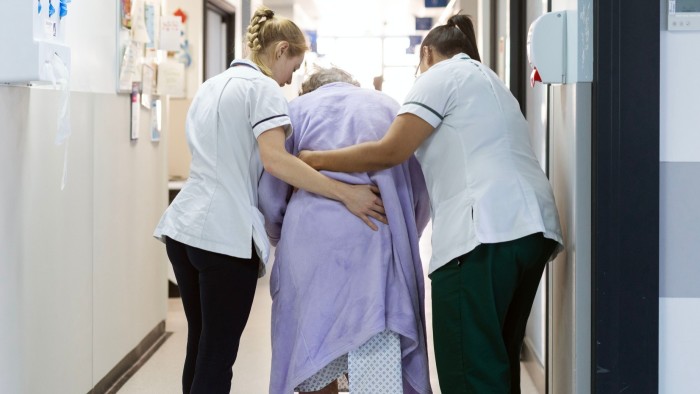The soaring demands of an ageing population on the National Health Service are one of the biggest challenges facing the medical staff at the University Hospitals of Leicester trust.
Within the next decade, the frail population in Leicester, Leicestershire and Rutland, in England’s East Midlands, is projected to grow at three times the rate of its general population.
Richard Mitchell, chief executive at the trust, who oversees the biggest and busiest emergency department in the country at the Leicester Royal Infirmary, is already feeling this pressure at his front door. Patient attendances at the department total about 20,000 each month, and demand for care is growing. Attendances are up 6 per cent on last year, and admissions by 11 per cent.
In response, the hospital is trialing a fresh approach to treating older patients in an attempt to ease the strain.
A Frailty Same Day Emergency Care (SDEC) Unit has been set up to provide quick and specialist assessment for older patients arriving at the emergency department (ED) and free up much-needed bed space.
Mitchell said far too many people who should be treated by local services were ending up in the emergency department as result of “insufficient” community capacity. “What we are seeing is growing demand on our front door, in particular older patients living with frailty — and we desperately need community care to change to deheat our organisation,” he told the Financial Times.
“GPs are busy and urgent treatment centres might not be provided. The only part of the healthcare system which is open 24 hours a day is the emergency department,” he added. “Its strength is its weakness.”
Christopher Miller, who helps to run the pilot unit that opened in January, said it was saving people many days spent in a hospital. “Sitting there in ED for up to 24 hours, possibly on a trolley, isn’t good for [patients]” he said.
Data show that 408 patients living with frailty have been referred to the new unit since it launched, of which 305 have been discharged without an admission. Of these, 71 per cent were discharged within 24 hours.
The unit also accepts direct referrals from GP surgeries and community hospitals, which helps to keep the patients out of the emergency room.
The NHS states that all hospitals with a 24-hour emergency departments should have an Acute Frailty service for “at least 70 hours a week”.
However, budget pressures mean not all hospitals can afford to roll out the service. In Leicester, staff do not yet know if they will have the funds to make the pilot a permanent service.

“A couple of patients I saw yesterday absolutely didn’t need to come into the hospital to see me,” said Ruw Abeyratne, the trust’s first director of health equality and inclusion.
“But making sure you’ve got the right people with the right expertise out in the community is part of the challenge and we don’t currently have the resources in people, never mind the money, to do that.”
The proportion of over-85s in the UK is projected to almost double between mid-2022 to mid-2047 — from 2.5 per to 4.3 per cent of the population.
The need to address the growing demands of older patients is not lost on politicians
One in 10 of attendees aged 80 or over who were not ultimately admitted waited longer than 12 hours in A&E, according to analysis of NHS England data from 2022-23 to 2023-24 by the Nuffield Trust think-tank.
The government’s 10-year plan for the NHS, to be unveiled in the spring, is expected to see a big focus on frailty and the health service redesign services to better support this demographic outside hospitals. This could see a rise in GPs, district nurses and pharmacies.
Among the three “big shifts” set out by health secretary Wes Streeting is a commitment to move more care away from hospitals and into communities.
“I subscribe to the idea of shifting to more community care,” said Miller. “The trouble is we don’t have the right people in the right setting to be able to deliver care that is appropriate in an alternative setting.”
While the unit aims to work around a lack of community-based care, as it grapples with the increased demand caused by the growing number of elderly patients, this comes with a significant cost.
In 2022, 22 per cent of patients with three or more long-term conditions accounted for 78 per cent of its acute hospital spend.

“The patients you have seen [in the unit] will be costing £500 to £1,000 to treat because they are in an acute setting,” said Mitchell. “If we can find a space in the community we could be spending £200 to £300.”
The NHS may have a number of services but they are often set up as individual silos which can be difficult to navigate, said Miller, “even for us as the clinicians working within the system.”
Despite the costs of running the pilot, for many patients it has proved a welcome alternative to long, uncomfortable waited in A&E.
Diane Wright, 89, was admitted to A&E after being rushed to the hospital with gastroenteritis before being moved into the SDEC unit.
“I was really very poorly but I have had excellent care here in this unit and as you can see the rooms are lovely,” she said. “This is just more relaxed and they have been really good with the information they give you.”
Data visualisation by Amy Borrett





